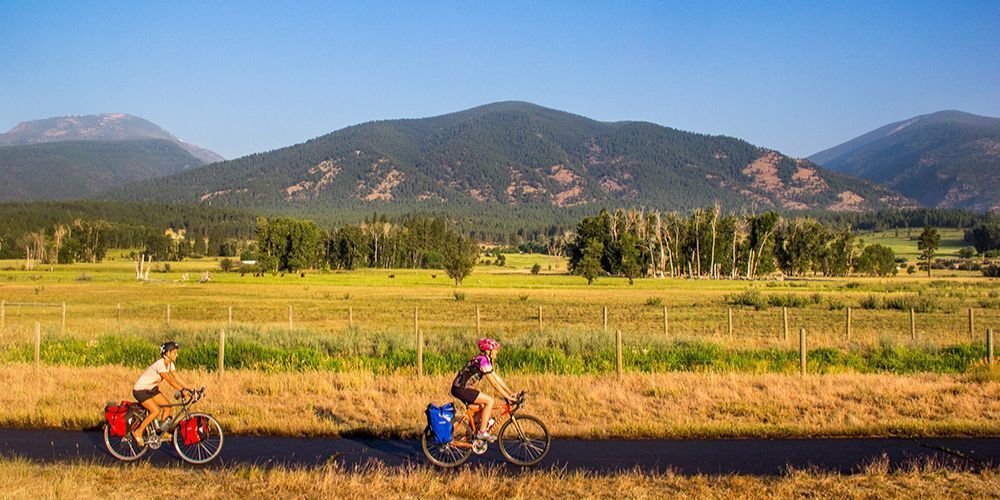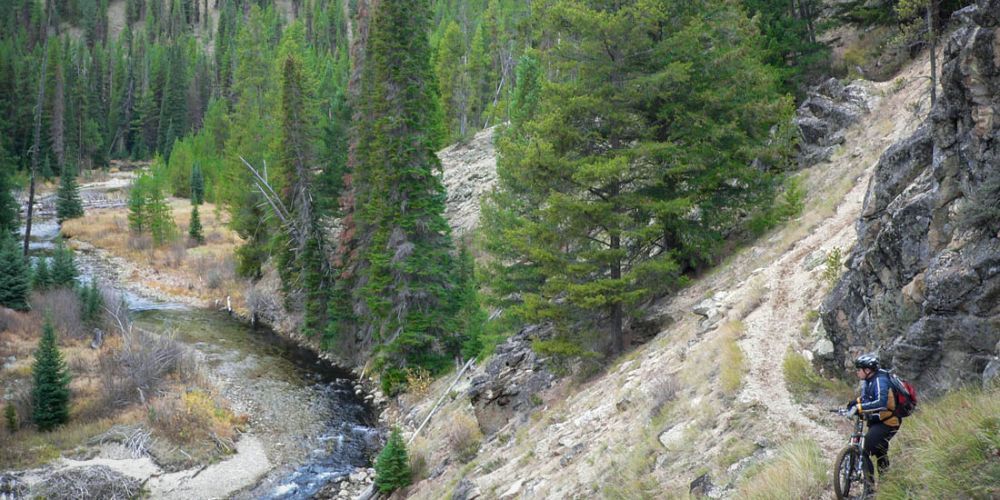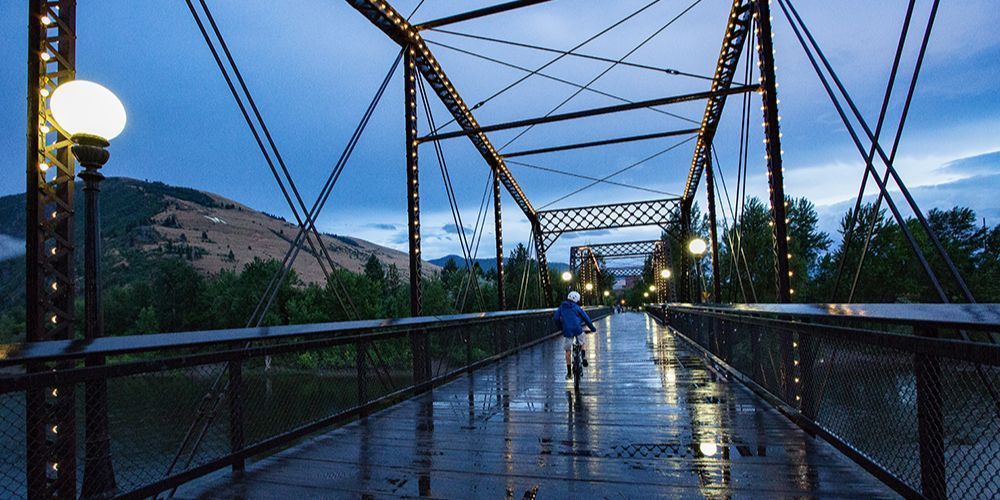Cycling in Montana: Explore Scenic Routes and Mountain Biking Adventures
Montana offers a playground for cyclists seeking both adventure and breathtaking views. Imagine pedaling along a winding trail with towering mountains on one side and expansive valleys on the other—a scene right out of a postcard that beckons anyone with a love for the outdoors and a bike.
But there's more beneath the surface of these well-known paths; each turn reveals not just natural beauty but also challenges that test your mettle as a cyclist. Whether you're navigating the ups and downs of Beartooth Highway or soaking in serene moments on the Bitterroot Trail, careful planning ensures an unforgettable journey. Cutting through this picturesque landscape, you find routes meticulously explored to guide you safely while offering an experience that captures Montana's wild spirit perfectly.
Some popular cycling routes in Montana include the Going-to-the-Sun Road in Glacier National Park, the Bitterroot Trail near Missoula, and the Whitefish Trail near Whitefish. These routes offer stunning scenery and a variety of terrain for cyclists of all skill levels.

Top Scenic Cycling Routes in Montana
Montana is a treasure trove for cyclists seeking awe-inspiring natural beauty. With countless scenic routes, it's hard to narrow down the best ones, but there are a few standout options that truly encapsulate the rugged grandeur of Big Sky Country. These routes are not just about the exercise; they're about immersing yourself in the untamed landscapes and feeling the pure thrill of exploration.
Going-to-the-Sun Road
This legendary road in Glacier National Park spans 50 miles and offers cyclists panoramic views of snow-capped peaks and deep valleys. As you pedal along this route, you'll experience nature's majesty at every turn. It's best to tackle this road during the quieter seasons of spring and fall when traffic is lighter, allowing you to fully absorb the serene beauty all around you without disturbance.
The Bitterroot Trail
The Bitterroot Trail is a 50-mile path that winds through the picturesque Bitterroot Valley, linking Missoula to Hamilton. What sets it apart is not only its length but also its well-paved paths, providing cyclists with a smooth and enjoyable ride. As you traverse this trail, you'll be treated to breathtaking vistas of the Bitterroot and Sapphire mountain ranges, creating an unforgettable cycling experience.
Beartooth Highway
For more seasoned riders seeking a thrilling challenge, the Beartooth Highway offers an exhilarating 68-mile stretch that elevates cyclists to over 10,000 feet. This demanding route is not for the faint of heart, but it rewards riders with sweeping, jaw-dropping views that make every push of the pedals worth it. The sense of accomplishment and wonder that comes from conquering this unparalleled route is something reserved for those who are willing to test their limits.
Each of these routes presents a unique opportunity to immerse oneself in Montana's natural wonders while embarking on an unforgettable cycling adventure. From epic mountain panoramas to tranquil valley views, these pathways offer an invigorating blend of physical challenge and visual splendor, making them must-visit destinations for any avid cyclist looking to explore Montana's unspoiled terrain.
Amidst the enthralling allure of these scenic cycling routes lies the crucial aspect of securing trails and ensuring safety for all adventurers. Let's now dive into some essential tips and guidelines for embracing these thrilling expeditions responsibly.
Secure Trails and Safety Tips
Cycling on Montana's scenic trails is truly exhilarating, but safety should always remain a top priority. Here are some essential tips to heed before you embark on your next adventure.
Pre-Ride Safety Check
Before setting off, give your bike a thorough once-over. Inspect the tires for any signs of wear and tear, ensuring they're properly inflated and in good condition. Check the brakes to make sure they're responsive, and test the chain to ensure it's well-lubricated and free from rust. Performing these checks can prevent mishaps and ensure a smooth, safe ride.
It's easy to get caught up in the excitement of exploring new trails, but taking a few minutes to inspect your bike can make a world of difference. Imagine zipping down a trail and realizing your brakes aren't working properly - not ideal! A pre-ride check will give you peace of mind and allow you to address any potential issues before they become major problems.
Wear Protective Gear
When cycling, protective gear is more than just an option - it's a necessity. A helmet is non-negotiable; it's your first line of defense in the event of a fall or collision. In addition, consider investing in bike gloves to protect your hands and reflective clothing for increased visibility, especially if riding during dawn or dusk hours. Prioritizing safety gear doesn't just minimize risk - it increases confidence and comfort, allowing you to fully enjoy the ride.
While we all hope for smooth rides with clear skies, inevitably weather conditions can change suddenly. Ensuring that you're visible to others on the trail is crucial for everyone's safety, particularly during low light conditions or inclement weather.
Stay Hydrated
In Montana's dry climate, dehydration is a real concern, especially during extended rides. Carry ample water and remember to hydrate regularly. Consider investing in a hydration pack or a water bottle holder for your bike so that hydration remains convenient throughout your ride. Staying hydrated won't just enhance your performance - it will keep you safe and healthy along the way.
Imagine cruising through Montana's stunning countryside and realizing you forgot to bring water - not ideal! Dehydration can lead to fatigue, dizziness, and decreased focus, putting you at risk both on the trail and off. Carrying ample water ensures that you're prepared for whatever lies ahead.
Use GPS and Maps
Montana offers an array of cycling trails, some less marked than others. To avoid getting lost, especially when exploring new territories, ensure that you download detailed maps and use GPS devices. Tools such as Strava, Google Maps, or dedicated cycling GPS devices can prevent unnecessary detours and provide valuable information about terrain features and trail difficulty levels.
Navigational aids are invaluable when exploring unfamiliar trails, helping you stay on course while unlocking hidden gems along the way. Whether you're tackling rugged mountain biking terrains or leisurely winding paths, being equipped with reliable maps and GPS tools enhances not only your enjoyment but also your safety during your Montana cycling adventures.
By adhering to these safety practices, you'll elevate both your enjoyment and safety while experiencing the breathtaking cycling opportunities that Montana has to offer.
Embarking into remote areas comes with its own set of challenges and thrilling exploits. Let's venture now into the untamed expanses where cycling enthusiasts discover uncharted paths and unparalleled natural beauty.
Biking in Remote Areas
Exploring Montana's remote biking routes is an unforgettable experience, but it comes with its own set of risks and demands. Being equipped and informed for the remote areas is crucial for a safe and enjoyable adventure.
Essential Emergency Gear
When you're far from civilization, it's essential to carry vital emergency gear. A basic first-aid kit can be a lifesaver in case of minor injuries like cuts and scrapes. Additionally, having a multi-tool for bike repairs, a tire repair kit, and extra tubes is paramount in ensuring that mechanical problems don't leave you stranded. These simple tools can turn a potential disaster into a minor inconvenience and keep you on your way.
Awareness of Wildlife
Montana's remote areas are home to a variety of wildlife, including bears, moose, and other large mammals. Because of this, it's important to be aware of how to react if you come across these creatures. Carrying bear spray is recommended as it can be an effective deterrent in case of bear encounters. Being vigilant and understanding how to behave around wildlife will ensure both your safety and the preservation of natural habitats.
Some might think that carrying a lot of gear seems like unnecessary weight when biking; however, remote areas require extra precautions. When biking in the wild, being prepared for potential emergencies is not just prudent—it's essential for survival.
Last summer, my friend had an accident while cycling through a remote area and was able to use his multi-tool to repair a snapped brake cable. He also had a basic first-aid kit with him which allowed him to clean and dress a small wound sustained in the fall. This could have been much worse had he not been carrying the necessary supplies.
Communication Tools
In many remote regions, cell phone coverage can be inconsistent or nonexistent. Therefore, bringing along a satellite phone or personal locator beacon is immensely important. In case of an emergency where outside help is needed, these devices can make all the difference by enabling you to communicate with rescue services or loved ones.
Nowadays, many people rely solely on their mobile phones for communication; however, these regular devices may not function in remote locations. Carrying specialized communication tools can literally be a lifeline in case of emergencies.
By being well-equipped with emergency gear and understanding the unique challenges of biking in remote areas, you'll be better prepared to handle any situation that arises during your thrilling adventures in Montana's wild landscapes.
Weather and Climate Considerations
When cycling in Montana, you'll encounter significant seasonal variations. Summer brings warm, dry conditions, creating an ideal environment for outdoor activities like biking. However, spring and fall exhibit fluctuating temperatures and the potential for sudden rainfall. These weather changes can impact your cycling experience, so it's essential to be prepared for anything nature throws at you during your adventure.
One of the most critical aspects of managing the ever-changing Montana weather is staying informed about real-time updates. Before embarking on any cycling journey, always check the current weather forecasts. Websites like Weather.com or local news channels provide reliable and timely updates on temperature, wind speed, precipitation, and more. Keeping track of these updates will help you make informed decisions about when and where to cycle, ensuring that you are well-prepared for whatever weather conditions lie ahead.
In addition to staying updated about the weather, dressing appropriately is key to enjoying your cycling adventure regardless of the conditions. Layering clothing is especially vital in Montana, where temperatures can vary significantly throughout the day. Wearing moisture-wicking base layers helps manage sweat and keeps you comfortable. Insulating mid-layers keep you warm when temperatures drop, while waterproof outer layers shield you from unexpected rain or wind. Being able to adapt to varying weather conditions through appropriate clothing layers ensures that you can focus on enjoying your ride without being hindered by external factors.
Remember, it's better to have an extra layer that you can take off if it gets too warm than to be caught underprepared when the temperatures shift suddenly.
By being aware of seasonal variations, staying updated with real-time weather forecasts, and effectively layering your clothing, you'll be well-equipped to handle the diverse weather conditions that Montana may throw your way during your cycling adventures.

Essential Gear for Montana Cycling
When gearing up for cycling in Montana, having the right equipment can make all the difference. Here's a breakdown of the essential gear you should consider.
High-Quality Bike
The type of bike you choose can greatly influence your experience on the trails. For rugged paths and mountainous terrain, a high-quality mountain bike with suspension is an excellent choice. The suspension will absorb the impact from rough trails, providing better control and comfort. On the other hand, if your route mainly consists of paved roads, a road bike is more suitable as it offers speed and agility. Investing in a high-quality bike that suits the terrain you plan to ride on will enhance your overall experience and keep you safe.
Hydration Packs
Staying hydrated is crucial during any cycling expedition, especially in Montana where elevation changes and varying temperatures can quickly deplete your energy. Hydration packs with built-in water reservoirs like CamelBak are popular among cyclists, as they provide convenient access to water without having to stop riding to take a drink. Additionally, these packs often come with additional storage compartments for carrying snacks, sunscreen, and small repair kits, making them an essential piece of gear for long rides.
Aside from hydration packs, carrying reusable water bottles in case of emergencies or extra-long rides is advisable. They can be easily attached to your bike frame using specialized bottle cages, ensuring easy access to water at all times.
Navigation Tools
Navigation tools play a vital role in ensuring you stay on course and maximize your cycling experience. GPS devices such as Garmin Edge are widely favored by cyclists for their advanced navigation features. These devices allow you to pre-load routes for offline access, providing confidence when exploring remote areas where cellular signal may be limited. With detailed maps and turn-by-turn directions, you can confidently explore new terrains without worrying about getting lost.
Repair Tools
Being prepared for unexpected mechanical issues is essential when venturing into the wilderness on a bike. Compact multi-tools, tire levers, and portable air pumps are indispensable for quick fixes on the trail. These tools enable you to handle common repairs such as fixing flat tires, adjusting components, or making minor adjustments to keep your bike in optimal condition throughout your journey.
It's worth noting that investing in quality repair tools not only ensures you can address minor issues on-the-go but also provides peace of mind knowing that you're well-equipped to handle unforeseen circumstances without cutting your adventure short.
Equipping yourself with these essentials will ensure that you're well-prepared to tackle the varying landscapes and challenges that Montana has to offer for cyclists.

Mountain Biking Hotspots in Montana
Montana's rugged terrain and breathtaking landscapes make it an ideal destination for mountain biking enthusiasts. With numerous trails spanning various difficulty levels, there's something for everyone, from beginners to seasoned riders. Let's explore some of the top mountain biking hotspots in the state.
Bangtail Divide Trail
Located near Bozeman, the Bangtail Divide Trail spans 31 miles and offers a thrilling mix of challenging climbs, exhilarating descents, and awe-inspiring views of the Bridger Mountains. As you conquer the trail's twists and turns, you'll be treated to panoramic vistas that showcase the natural splendor of the region. This trail is perfect for those seeking a substantial and rewarding mountain biking adventure.
Helena Ridge Trail
Nestled near Helena, the Helena Ridge Trail boasts an 11-mile loop renowned for its flowy singletrack and captivating panoramas of the Helena Valley. Intermediate to advanced riders will appreciate the diversity of terrain and the opportunity for a dynamic riding experience. The seamless flow of the singletrack combined with the picturesque surroundings makes this trail a must-visit for mountain biking enthusiasts seeking a memorable ride.
Rattlesnake National Recreation Area
For riders exploring near Missoula, the Rattlesnake National Recreation Area presents an extensive network of trails covering 73 miles amidst lush forests and alpine meadows. The diverse topography provides options suitable for varying skill levels, ensuring that both novice and experienced riders can find a route that aligns with their abilities. The rugged nature of the trails combined with the serene natural surroundings creates an invigorating experience for mountain bikers seeking adventure and exploration.
These mountain biking hotspots in Montana offer an unmatched blend of natural beauty, exhilarating challenges, and diverse landscapes, catering to riders seeking adrenaline-pumping adventures and scenic escapades. Immerse yourself in Montana's breathtaking wilderness while indulging in an invigorating mountain biking experience.
Montana's cycling offerings are as diverse as its landscapes, promising unforgettable adventures for cyclists of all skill levels. Whether you seek heart-pounding thrills or serene rides through nature's finest, Montana welcomes you with open arms.
Author: William Flaiz
Check out these other activities in Montana
Check out activities in these nearby states: Idaho , North Dakota , South Dakota , Wyoming
